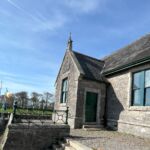
2,847
Abbeyleix Heritage House
Abbeyleix Heritage House is Laois' biggest history museum, community centre and business hub.
Reminder for this evening at 7pm:
This content isn't available at the moment
When this happens, it's usually because the owner only shared it with a small group of people, changed who can see it, or it's been deleted.
Shown are two images of Morrisseys dating back to 1810- one is an original photograph, while the black and white is a copy.![]()
![]() The Morrissey's would have only been in Abbeyleix a short time when this photograph was taken- in fact, the town of Abbeyleix was only recently constructed, having been built during the late 18th century. New Town, or New Abbeyleix, was planned by the De Vesci family, Old Abbeyleix was already a settlement along the river Nore. The Old Town was demolished, and the New Town was built away from the river to avoid flooding, and in a favourable location in terms of trading.
The Morrissey's would have only been in Abbeyleix a short time when this photograph was taken- in fact, the town of Abbeyleix was only recently constructed, having been built during the late 18th century. New Town, or New Abbeyleix, was planned by the De Vesci family, Old Abbeyleix was already a settlement along the river Nore. The Old Town was demolished, and the New Town was built away from the river to avoid flooding, and in a favourable location in terms of trading. ![]()
![]() Morrisseys started out as a single storey building- though, as is evident today, the building is two storeys tall! The family also at one stage owned the De Vesci Arms Hotel, which was located along the Main Street near the Monument and Market House (as well as beside the old courthouse)#LaoisL#curatortuesdaye#abbeyleixheritagetowne#abbeyleixheritagei#abbeyleixheritagehouseh#foundinthearchivesh#archivesh#Abbeyleixy#curatortuesdaye#museumu#irishhistorys#heritagehouseh#historys#Genealogya#genealogyresearchearch
Morrisseys started out as a single storey building- though, as is evident today, the building is two storeys tall! The family also at one stage owned the De Vesci Arms Hotel, which was located along the Main Street near the Monument and Market House (as well as beside the old courthouse)#LaoisL#curatortuesdaye#abbeyleixheritagetowne#abbeyleixheritagei#abbeyleixheritagehouseh#foundinthearchivesh#archivesh#Abbeyleixy#curatortuesdaye#museumu#irishhistorys#heritagehouseh#historys#Genealogya#genealogyresearchearch
WILD BEE FESTIVAL 2025🐝![]()
![]() Heritage House will be hosting the Wild Bee Festival, an annual celebration, this weekend Saturday 21st June and Sunday 22nd June!
Heritage House will be hosting the Wild Bee Festival, an annual celebration, this weekend Saturday 21st June and Sunday 22nd June! ![]()
![]() This event is coordinated by the National Biodiversity Data Centre ( also in collaboration with Abbeyleix’s Tidy Towns and Laois County Council🌳)
This event is coordinated by the National Biodiversity Data Centre ( also in collaboration with Abbeyleix’s Tidy Towns and Laois County Council🌳)![]()
![]() #abbeyleix #wildbeefestival #pollinators #tidytowns #laois
#abbeyleix #wildbeefestival #pollinators #tidytowns #laois
TRIVIA THURSDAY:![]()
![]() This week’s quiz is about the summer solstice! ☀️
This week’s quiz is about the summer solstice! ☀️![]()
![]() forms.gle/nmcJsGFfDzkFWiEy8
forms.gle/nmcJsGFfDzkFWiEy8
📚 Curator Tuesday Spotlight!![]() Today we’re featuring an 1861 edition of The Life of Horace (aka Quintus Horatius Flaccus), translated from Latin by Charles Anthon. Horace, born in 65 BCE in Venusia, Italy, became one of Rome’s most celebrated poets- famous for his Odes and satirical works.
Today we’re featuring an 1861 edition of The Life of Horace (aka Quintus Horatius Flaccus), translated from Latin by Charles Anthon. Horace, born in 65 BCE in Venusia, Italy, became one of Rome’s most celebrated poets- famous for his Odes and satirical works.![]()
![]() This particular copy was once owned by E. Vesey of the de Vesci family of Abbeyleix- likely Eustace Vesey, Oxford graduate, British Army captain, and father to the 5th Viscount de Vesci. Eustace married Constance Mary Lawley, third daughter of lord Wenlock, in St. George’s, Hanover Square, London, in 1877. The couple resided at Sedgehill in Wiltshire, England. He died young in 1886 at age 36 while in Abbeyleix from peritonitis (usually caused from an infection or burst appendix).
This particular copy was once owned by E. Vesey of the de Vesci family of Abbeyleix- likely Eustace Vesey, Oxford graduate, British Army captain, and father to the 5th Viscount de Vesci. Eustace married Constance Mary Lawley, third daughter of lord Wenlock, in St. George’s, Hanover Square, London, in 1877. The couple resided at Sedgehill in Wiltshire, England. He died young in 1886 at age 36 while in Abbeyleix from peritonitis (usually caused from an infection or burst appendix). ![]()
![]() #CuratorTuesday #Books #Horace #Abbeyleix #IrishHistory #BookHistory #LatinLiterature #HistoricCollections #DeVesciFamily #Laois #heritagehouse #abbeyleixheritagetown #museum #library #archives #reading
#CuratorTuesday #Books #Horace #Abbeyleix #IrishHistory #BookHistory #LatinLiterature #HistoricCollections #DeVesciFamily #Laois #heritagehouse #abbeyleixheritagetown #museum #library #archives #reading



